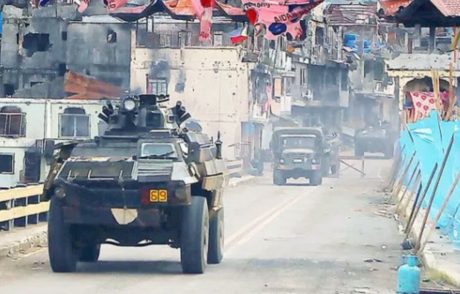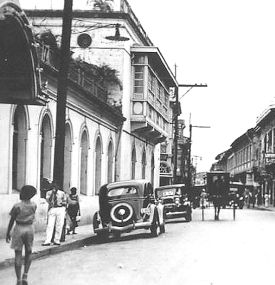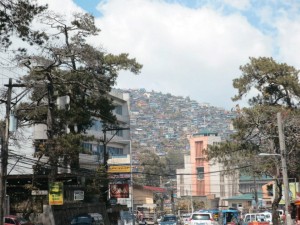
There’s a lot of talk lately about “re-building” Marawi City. Jose Montelibano in his Inquirer column today offers thoughts on what needs to be considered to not just to do that but to do it right, as in build A New Marawi that, at the same time, puts it on a path towards becoming a true modern Islamic city…
If Marawi is to be an Islamic city, then perhaps it can be designed to be such according to the tenets and way of life befitting an Islamic city. For one, there should be no informal settlers or squatters. From the onset, no colonies of informal settlers should ever be permitted. How national government or the ARMM, under the present setup or under the proposed Basic Bangsamoro Law, will rebuild or create the new Marawi should be the example of how a brighter future can already be part of a masterplan. After all, the issue of ancestral domain is key to the peace agreement and the autonomy of Muslim Mindanao. Informal settlers should become a thing of the past.
It is interesting that Montelibano highlights the issue of “informal settlers” (a.k.a. squatters). It directs our attention to the credibility of those who seek to participate — and, perhaps, lead — in building the sort of city that ought to be rising from the rubble of this war-torn city. The trouble is, there is hardly any authority in the Philippines who could credibly tell anyone how to build a Filipino city where squatters are “a thing of the past”. This is because there are hardly any cities — or even towns — in the Philippines that are free of some form of squatter infestation.
| SUPPORT INDEPENDENT SOCIAL COMMENTARY! Subscribe to our Substack community GRP Insider to receive by email our in-depth free weekly newsletter. Subscribe to our Substack newsletter, GRP Insider! Learn more |

Montelibano looks far overseas to Japan for a model to latch onto citing the city of Hiroshima which, following its horrible history, did not become “a symbol of violence”. Instead “Japan used the tragedy of Hiroshima to be a beautiful lesson of the present and the future,” Montelibano writes.
What is interesting, however, is that Montelibano did not need to look that far off for lessons on how cities reduced to rubble in a war are rebuilt. He only needs to look back at what happened to the Philippines’ own capital, Manila. “Modern” Manila, today, offers a stark contrast to the city it once was — the one it was before World War II. Manila today is a steaming agglomeration of political feifdoms — a feudal metropolis where efforts to implement coherent urban management systems that harness economies of scale is virtually impossible thanks to the kanya kanya and ako muna mentality of both local government officials and the inhabitants themselves. It is, by all intents and purposes, less modern than it was back in the 1930s.

There are already lessons staring Filipinos in the face that could be learnt before another big “rebuilding” project fuelled by mere good intentions rather than actual hard-nosed expertise and sound thinking is started. Filipinos only need take heed of the reality of what they, as a people, are really capable of. Are Filipinos true builders? Or are they mere destroyers? Do we strive ofr excellence or does pwede na yan routinely cut it for us? The journey towards building a New Marawi City should begin by answering those timeless question with eyes wide open.
- This latest Filipino-style ‘anti-corruption’ circus proves that the Philippines needs a serious reboot - November 16, 2025
- Filipinos literal sitting ducks as wind and floods from natural tropical typhoons amplified by years of neglect bear down - November 9, 2025
- Rally NA NAMAN??? - September 20, 2025
Let’s hire Arch.Palafox to do the masterplan of rebuilding Marawi.
@Rommel He’s the greatest Filipino urban planner, IMHO but sadly his work got snub to the previous administrations. Hopefully, President Duterte will not snub him & he could become a part of the cabinet position under his administration especially for the rebuilding of Marawi City in which it’ll take years to fix it. If he could make Marawi City into a modernized city which are similar to Singapore, Sydney, Tokyo, Seoul, Dubai, Hong Kong, etc. then I will leave this city of Manila which are very chaotic & unsafe & go to that city & die there. And hopefully it won’t repeat its tragedy again where an Islamic terrorists storm that city & establish an Islamic Caliphate for them. Besides better urban planning, Marawi City need a greater security against that kind of threat in the future. Make that Marawi City become a peaceful, developed and a diversity city and will not stained by radical ideology, hatred & divisions. #BangonMarawi
A slight problem here is that, since the Philippines has no functioning land titling system (and indeed doesn’t even seem to understand the basic concept), ALL Filipinos are illegal settlers. Any such move to evict squatters will inevitably end up focused on specific undesirables, ie., people who don’t have the requisite tribal or religious credentials.
I’m not arguing against the basic premise here – that a combination of squatting and atrociously poor planning and design are two of the main reasons the country looks like it does. I’m just saying that before you can divide the population into “illegal” and “legal” occupiers of land, one must first fix the law and institutions relating to real property. Not theoretically difficult, given the existence of modern GIS technology and a lot of historical experience, but difficult for the Filipino, who insists on reinventing the wheel in the endless pursuit of Filipino Pride.
Marius,
I am not sure whether I understand your very first line/sentence (functioning titling system).
I tried to find a good translation of what I think you are refering to. And the only thing I can come up with is the cadastre/cadaster.
Physical mapping a prerequisite, but that’s not the whole story. You’re right of course – the Philippines doesn’t even map things properly (I have an “up-to-date” map of my area which was drawn , by hand, in 1984). More important is the pact between the State and the populace which guarantees security of title. This doesn’t happen, partly because the government can’t guarantee all the overlapping, fake titles issued by the “authorities”.
Possibly NCR is properly mapped and the law is enforced. Elsewhere, it’s the Wild West.
Cities are made of people and what are the people of Marawi like? To hear it told the people of Marawi are nothing but gangsters and criminals. The city itself being a hotbed of criminality, honour killings, and nothing worthwhile in general.
“On the first day, we weren’t too bothered because it was just gunshots. Marawi has always been very chaotic: family feuds or fights over women and money. They’re called ‘rido’ (honour killings). When it’s a ‘rido’, the police don’t bother following up.”
Shattered lives: Marawi’s refugees
Those same people will be returning and bringing the same problems with them. What good will it do to build an esplanade along the river when the problem is not the architecture of the city but the moral and spiritual condition of the people which is the real problem.
“If we examine what destroyed Marawi, it was not the architecture of the buildings but the architecture of almost everything else. How can Marawi be rebuilt without returning the features and factors that ultimately destroyed it? The physicality of Marawi was badly damaged but can be more easily rebuilt, or replaced. But the dynamics of the people, the culture, the religion and the history – how can these be reconstructed without returning to the pattern that destroyed it?”
A New Marawi
As for squatters? Duterte did a real disservice by proclaiming Marawi free. Now everyone will want to return immediately to the rubble of their homes. Squatters will be everywhere because no one will want to give up their beloved home even if it is in ruins. And what about the AFP saying there is over 1 billion hidden in the debris? Treasure hunters will be tearing up the place in no time. It’s a real mess and it will be so for quite some time.
These squatters aren’t just aliens, drifters and undesirables. They’re new world barbarians, conquering free spaces and making them their own.
Unless, we junk the Cory Aquino constitution, that guarantees protection of Squatters, to squat on any land. There will be no good outcome, in the rebuilding of Marawi City. The Builders will build the city; but the Squatters will build their own shacks, beside it. What you will see is like any urban city in the Philippines, full of squatters, with filth , garbage and decay around.
The security of Marawi city, must be incorporated in the rebuilding. That no ISIS, or any terrorist group will again lay waste to the city…
We need Urban Planners to plan, and Urban Builders to implement the plans. A good system of audit and accounting, must be implemented. Because Filipinos, have the tendency to steal money from any funds, in any way they can. Look at the Typhoon Yolanda Funds, stolen by Mar Roxas and Pnoy Aquino. Look at the houses they built, and the way they built them !
hey how about the novel idea of practicing birth control?? might help solve alot of problems….oh but i forgot,’children are a blessing’…..sure, keep bringing them into a world of filth,poor housing conditions,destroyed environment,malnutrition,etc.What could possibly go wrong ???
Too hard and too sinful, it seems…